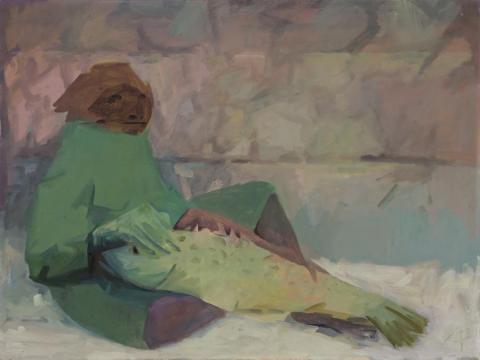WOMAN WITH COD, 1963
SAM FULLBROOK
oil on canvas
76.0 x 101.0 cm
signed lower right: SF
Private collection, Melbourne
Thence by descent
Private collection, New South Wales
St John Moore, F., Sam Fullbrook: Racing Colours, National Gallery of Victoria, Melbourne, 1995, cat. 17, p. 31
Old Man with Cod, 1963, oil on canvas, 69.0 x 51.0 cm, collection of the Museum and Art Gallery of the Northern Territory, Darwin, illus. in St John Moore, F., Sam Fullbrook: Racing Colours, National Gallery of Victoria, Melbourne, 1995, cat. 17, p. 31
'Maverick' is a word often used to describe an artist. However, no artist wears the term as fittingly as the late Sam Fullbrook. In a rich and varied life he travelled and worked around Australia as a timber cutter, stockman, soldier, horse trainer and painter, distilling his observations of people, places, and creatures into delicate paintings that sat oddly with his gruff exterior.
Fullbrook was a student of the Max Meldrum School of tonalists. The self-discipline and work-ethic he imposed at this time was noted by fellow students and underpinned his working methods throughout his life. For example he would prepare for portrait commissions with hours of life drawing. Essentially, he would train or prepare himself as he would one of his horses in the lead up to a race.
His many celebrated portraits include the 1974 Archibald Prize winner of jockey Norman ('Whopper') Stephens, who endured over twenty sittings for the portrait, some of which were spent asleep on the artist's Chesterfield lounge. The racing colours shown in the portrait are not Fullbrook's, but those of fellow owner Mick Bacon. Fullbrook's registered racing colours were those of that most laconic Australian bird the Galah; pink, grey sleeves and white cap.
Woman with Cod, 1963 evolved as part of Fullbrook's aeroplane project; a series of trips he made to the Darling River, New South Wales between 1963 and 1965 with the aim of creating works for an exhibition at the South Yarra Gallery, Melbourne.1 These trips, often plagued by foul weather and car troubles, were centred at Dunlop Station where he would sketch the surrounding landscape and then return to a shed on the property where he'camped' while he developed the drawings into paintings.
Amongst the paintings created during this time are several works widely considered to be his best. These include River Idyll, 1963 (Queensland Art Gallery, Brisbane), and Emu and Aeroplane, 1965 (University of Western Australia, Perth). Woman with Cod, 1964, sits well amongst these works. Its companion work, Old Man with Cod, 1963, is held in the collection of the Museum and Art Gallery of the Northern Territory, Darwin. Another work from this period, Trees on The Darling, 1964 was awarded joint winner of the 1964 Wynne Prize at the Art Gallery of New South Wales, Sydney.
The scene depicted in Woman with Cod is serene. The fish, destined for the fire, rests on the old woman's lap. Her hands holding the fish appear to caress it, the image showing the compassion and respect that the woman has for the creature. The cod is food and the woman is'singing the fish'. The old woman sees creatures as whole; one fish is'all fish', the respect shown at this point ensures the fish will continue to provide food for the woman's family. Fullbrook's understanding of, and empathy for Aboriginal people was profound. Working side by side with Aboriginal stockmen during the late 1930s he was shocked by the social injustice he witnessed, and this affected him deeply.
The cod's resignation to its fate is evident through its expression, which in a gesture brings Fullbrook's sense of humour to the work. The work is painted in his typical way with broad minimal brush strokes delivering the paint. Crash or crash through is the aim, hit and miss the method. Despite this cavalier approach, the results are surprisingly delicate with tender harmonies of high key colour that are calligraphic and spontaneous in nature.
1. St John Moore, F., Sam Fullbrook: Racing Colours, National Gallery of Victoria, Melbourne, 1995, p. 10
HENRY MULHOLLAND
